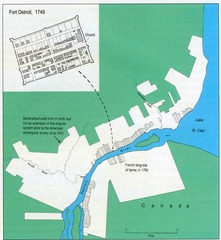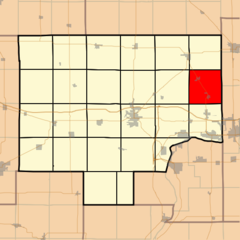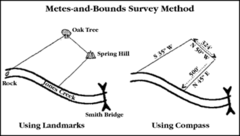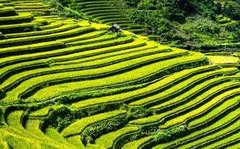Chapter 10: Agriculture (HUMAN GEOGRAPHY AP)
0.0(0)
Card Sorting
1/103
Earn XP
Description and Tags
Study Analytics
Name | Mastery | Learn | Test | Matching | Spaced |
|---|
No study sessions yet.
104 Terms
1
New cards
Intensive Agriculture
agriculture that involves greater inputs of capital and paid labor relative to the space being used. (LOTS OF WORK BUT SMALLER LAND).
2
New cards
Intensive Agriculture example
Any farming that requires manual labor like intensive subsistence WET rice dominant or plantation agriculture. Although the have many workers, they can only work with small land because humans can't manually work efficient enough to actually work on big lands.
3
New cards
Extensive Agriculture
Agriculture that uses fewer inputs of capital and paid labor relative to the amount of space being used. (LOTS OF LAND BUT NOT MUCH LABOR).
4
New cards
Extensive Agriculture example
This is usually in MDCS and farming like dairy farming or grain farming. These agriculture have advanced technology and use a lot of machinery, requiring little workers. Because they have machines that can work so much quicker and efficient, they often are able to afford using big lands. Sometimes causing overproduction of foods.
5
New cards
1st Agricultural Revolution
Th first domestication of plants and animals. People became sedentary (and the same land was used to farm every year.)
-All the farming taking place was subsistence (manual labor and used simple tools).
-Job specialization occurred (causing the major start of the widening gap of gender differences to occur).
-Food supply and total population increased.
-Neolithic revolution is the other name.
-All the farming taking place was subsistence (manual labor and used simple tools).
-Job specialization occurred (causing the major start of the widening gap of gender differences to occur).
-Food supply and total population increased.
-Neolithic revolution is the other name.
6
New cards
2nd Agricultural Revolution
-Accompanied the Industrial revolution that begain in Great Britain in the 18th century.
-A series of innovations, improvement, and technique used to improve food production.
-Mechanization
-Advanced transportation
-Large scale-irrigation
-New soil preparation methods and fertilizers.
-A series of innovations, improvement, and technique used to improve food production.
-Mechanization
-Advanced transportation
-Large scale-irrigation
-New soil preparation methods and fertilizers.
7
New cards
3rd Agricultural Revolution
Origins in North America in the mid-20th century.
Mechanization:
-Replacement of human labor with machines. (Chemical farming).
-Use of synthetic fertilizer, herbicides, and pesticides (food manufacturing).
-Addition of economic value through processing, canning, refining, and packaging.
-Industrialization of agriculture.
Mechanization:
-Replacement of human labor with machines. (Chemical farming).
-Use of synthetic fertilizer, herbicides, and pesticides (food manufacturing).
-Addition of economic value through processing, canning, refining, and packaging.
-Industrialization of agriculture.
8
New cards
Green Revolution
Rapid diffusion of new agricultural technology, especially new high-yield seeds and fertilizers.
9
New cards
Green Revolution example
New wheat miracle seed (created by new agricultural technology) were transported to LDCs such as India, Asia, or Latin America, preventing a food crisis in these region.
10
New cards
Columbian Exchange
The exchange of plants, animals, diseases, and technologies between the Americas and the rest of the world following Columbus's voyages.
11
New cards
Columbian Exchange example
This created a diffusion of crops from one country/region to another. Settler learned how to plant using the native American's technique while Settlers taught Natives how to make or use tools the natives didn't have.
12
New cards
Subsistence Agriculture
Agriculture designed primarily to provide food for direct consumption by the farmer and the farmer's family.
13
New cards
Subsistence Agriculture example
A intensive subsistence wet rice farmer could only have enough workers to feed mouths instead of going to a market and selling it on the global market.
14
New cards
Commercial Agriculture
Agriculture undertaken primarily to generate products for sale off the farm.
15
New cards
Commercial Agriculture example
Dairy farming is to make milk and sell it as quick as possible to the market so it doesn't spoil. Also milk alone isn't enough to feed a family.
16
New cards
Long Lot
settlement pattern in southern Quebec and some other areas of Canada where individual lots tend to be long and narrow and extend back from major rivers or roads. Mainly influenced by the French (darn their fancy baguettes) which came to America, primarily Texas and Louisiana.
17
New cards
Long Lot example

18
New cards
Township and Range
A rigid grid-like land division scheme designed by Thomas Jefferson, used to dispersal of settlers evenly across farmlands of the U.S. interior.
19
New cards
Township and Range example

20
New cards
Metes and Bounds
A method of land description which uses natural features to demarcate irregular parcels of land. Found on the east coast of North America.
21
New cards
Metes and Bounds example

22
New cards
Dispersed Rural Settlement
A rural settlement pattern characterized by isolated farms rather than clustered villages.
23
New cards
Dispersed Rural Settlement example
Typical of the North American rural landscape, farmers living on individual farms isolated from their neighbors.
24
New cards
Clustered Rural Settlement
A rural settlement in which the houses and farm buildings of each family are situated close to each other and fields surround the settlement.
25
New cards
Clustered Rural Settlement example
This settlement includes homes, barns, tool shed, and consumer services such as religious structures, school, and shops. Live near each other.
26
New cards
Terrace Farming
The cutting out of flat areas (terraces) into near vertical slopes to allow farming. Terrace farms appears as steps cut into a mountainside. Terrace farming is a type of farming that was invented by the Inca people who lived in the South American mountains. This farming method has made cultivation of crops in hilly or mountainous regions possible.
27
New cards
Terrace Farming example

28
New cards
Milkshed
The area surrounding a city from which milk is supplied.
29
New cards
Milkshed example
Milk must be close to where a market resides because milk can spoil easily and is perishable.
30
New cards
Agribusiness
Commercial agriculture characterized by integration of different steps in the food-processing industry, usually through ownership by large corporations. (Most commonly means an agriculturally related business that supplies farm inputs, such as machinery and seed supply.)
31
New cards
Agribusiness example
food production and services related to this processing, packaging, storing, distributing, and retailing. Also encompasses enterprise such as tractor manufacturing, fertilizer production, and seed distribution.
32
New cards
Enclosure Movement
The process of consolidating small landholdings into a smaller number of larger farms in England during the eighteenth century.
33
New cards
Enclosure Movement example
The British government transformed the rural landscape by consolidating individually owned strips of land surrounding a village into a single large farm owned by an individual.
34
New cards
Sustainable Agriculture
Farming methods that preserve long-term productivity of land and minimize pollution, typically by rotating soil- restoring crops with cash crops and reducing in-puts of fertilizer and pesticides.
35
New cards
Sustainable Agriculture example`
Any farming that does not harm the environment, they are conscious of sensitive land management, limited use of chemical , and better integration of crops and livestock.
36
New cards
GMOs (genetically modified organisms)
Organisms that have had their genes altered in a laboratory for specific purposes, such as disease resistance, increased productivity, or nutritional value allowing growers greater control, predictability, and efficiency
37
New cards
GMOs (genetically modified organisms) example
Apples have been modified to not brown as fast, be resistant to bruising, and to be resistant against food transferable to human diseases.
38
New cards
Biotechnology
A form of technology that uses living organisms, usually genes, to modify products, to make or modify plants and animals, or to develop other microorganisms for specific purposes.
39
New cards
Biotechnology example
The creation of crops that express anti pest characteristics naturally, making them very resistant to pests, as opposed to having to keep dusting them and spraying them with pesticides. An example of this would be the fungus Bacillus thuringiensis genes being transferred to crops. The crop is genetically modified to have this gene.
40
New cards
LESS DEVELOPED agriculture regions
-Shifting Cultivation (Swidden)
-Pastoral nomadism
-Intensive subsistence WET RICE dominant (paddy)
-Intensive subsistence WET rice NOT dominant
-Plantation Agriculture
-Pastoral nomadism
-Intensive subsistence WET RICE dominant (paddy)
-Intensive subsistence WET rice NOT dominant
-Plantation Agriculture
41
New cards
MORE DEVELOPED agriculture regions
-Mixed crop and livestock
-Dairy farming
-Grain farming
-Livestock ranching
-Mediterranean Agriculture
-Commercial gardening and fruit farming
-Dairy farming
-Grain farming
-Livestock ranching
-Mediterranean Agriculture
-Commercial gardening and fruit farming
42
New cards
Environmental Impact for Shifting Cultivation (Swidden)
The land is dedicated to shifting cultivation has found itself RAPIDLY DECLINING at a rate of 0.2% per year due to such DRASTIC and ACTIVE DEFORESTATION-This large scale destruction of trees has also led to massive CARBON DIOXIDE RELEASE that has built up in the atmosphere, traps greenhouse gases in the atmosphere and has contributed to GLOBAL WARMING
43
New cards
Environmental Impact for Pastoral nomadism
The grazing and overgrazing of fields and farm lands by ruminant herds leads to vegetation depletion, tearing (in part) and hardening of farm/non-farm top soils, erosion and flooding, destruction of food and economic crops, loss of biodiversity and a host of other adverse environmental effects. Because of the arid climate and the overall location of the belt, their CHOICE OF ANIMALS are limited to camels, goats, and sheep.
44
New cards
Environmental Impact for Intensive subsistence WET RICE dominant (paddy)
FLOODING which is a mechanism to irrigate crops after they are plowed. Too little or too much rain can damage and impact the crop and the land itself.
45
New cards
Environmental Impact for Plantation Agriculture
Because this type of agriculture grows crops YEAR ROUND it can be exhausting for the environment-OVERFARMING causes damage to the soil by depleting it of nutrients
46
New cards
Environmental Impact for Mixed Crop & Livestock
Various crops can easily deplete the soil of its nutrients, in which that case would affect the environment because it will no longer be able to grow crops-Why it was necessary have a CROP ROTATION system. A contraction in meat consumption per person in high-income countries would benefit human health, mainly by reducing the risk of heart disease, obesity, and colorectal cancer.
47
New cards
Environmental Impact for dairy farming
Dairy cows and their manure produce greenhouse gas emissions which contribute to climate change. Poor handling of manure and fertilizers can degrade local water resources. And unsustainable dairy farming and feed production can lead to the loss of ecologically important areas, such as prairies, wetlands, and forests. Lead to damage of land because a large number of livestock (milk farming) could result in overgrazing.
48
New cards
Environmental Impact for Grain Farming
Embodied global warming resulting from the fertilizer applied to farmers' fields to increase their wheat harvest. This arises from the large amount of energy needed to make the fertilizer and from nitrogenous oxide gas released when it is degraded in the soil."
Other processes, such as tilling the soil, irrigating, harvesting, and using electricity to power mills and bakeries, were also energy-intensive, but they did not amount to nearly as much as fertilizing. HEAVILY MECHANIZED.
Other processes, such as tilling the soil, irrigating, harvesting, and using electricity to power mills and bakeries, were also energy-intensive, but they did not amount to nearly as much as fertilizing. HEAVILY MECHANIZED.
49
New cards
Environmental Impact for Mediterranean Agriculture
With the development of urban areas there has been a massive loss of farmland that has required expansion into drylands that in turn requires massive water
50
New cards
Environmental Impact for Commercial Gardening & Fruit Farming
Environmental Impacts: since truck farms are efficient, they use a lot of machines that could potentially harm or DAMAGE THE LAND as well as the environment (air quality)
51
New cards
Environmental Impact for livestock ranching
Overgrazing that occurred of practicing this type of farming resulted in increased damage of the land.
52
New cards
Geographic Location for Shifting Cultivation (Swidden)
Tropical rainforest: Latin America, sub-Saharan Africa, and Southeast Asia.
53
New cards
Geographic Location for Pastoral nomadism
Primarily in the large belt of arid and semiarid land that includes Central and Southwest Asia and North Africa.
54
New cards
Geographic Location for Intensive subsistence WET RICE dominant (paddy)
In Asia predominantly South Asia, Southeast Asia and East Asia.
55
New cards
Geographic Location for Plantation Agriculture
In tropic/sub-tropic area: Latin America, Africa, and Asia, but owned by Europeans or North America and sale primarily to developed countries.
56
New cards
Geographic Location for intensive subsistence WET rice NOT dominant
In much of the interior of India and northeastern China.
57
New cards
Geographic Location for Mixed Crop & Livestock
Most common in United States (U.S. west of the Appalachian and east of 98 degree longitude and much of europe from France to Russia.)Fields require less attention in the winter than in the spring, when crops are planted, and in the fall, when they are harvested. Meanwhile, livestock require year-long attention. A mix of crops and livestock also reduces seasonal variations in income; most income from crops comes during the harvest season, but livestock products can be sold throughout the year.
58
New cards
Geographic Location for Dairy Farming
Large Urban area of northeastern United States, southeastern Canada, and northwestern Europe. Also become important type of farming in South and East asia.
59
New cards
Geographic Location for Grain Farming
Eurasia, North America, and in South America. Many tropical areas, where it is hot and humid year-round, mostly in warm weathers.
60
New cards
Geographic Location for Livestock Ranching
Every continent, largest beef in Brazil, rare in Asia and in Europe, and mostly wildlife ranches. MOST COMMON IN TEMPERATE DRY AREA. ARID LOCATIONS.
61
New cards
Geographic Location for Mediterranean Agriculture
Exist on the land that borders of the Mediterranean sea on in Southern Europe , North Africa, and western Asia. Also in California, central Chile, the southwestern part of South Africa, and southwestern Australia. They have hot, dry summers and cool, wet winters
62
New cards
Geographic Location for Commercial Gardening & Fruit Farming
Predominant type of agriculture in southeastern U.S., long growing season and humid climate.
63
New cards
Product Produced for Shifting Cultivation (Swidden)
Upland rice in Southeast Asia, maize (corn) and manioc (cassava) in South America, and sorghum in Africa. Yams, sugarcane, plantain, and vegetables are also grown in some regions.
64
New cards
Product Produced for Pastoral nomadism
Milk, clothing from skin or hair, and tents made by skin.
65
New cards
Product Produced for Intensive subsistence WET RICE dominant (paddy)
RICE (obviously!!!!)
66
New cards
Product Produced for Intensive subsistence WET rice NOT dominant
Rarely rice but MAINLY grains like wheat, barley, millet, oats, corn, kaoliang, soghum, and soybean.
67
New cards
Product Produced for Plantation Agriculture
Cash crops (usually specializes in one crop): Banana, sugar, coffee, cacao, rubber, and tea.
68
New cards
Product Produced for Mixed Crop & Livestock
Crops: Wheat, maize, rice, potatoes, soy bean, and corn. Livestock can be pigs, cows, chickens, and goats.
69
New cards
Product Produced for Dairy Farming
Milk, cheese, yogurt, Ice cream, and butter.
70
New cards
Product Produced for Grain Farming
Barley, wheat, millet, brown rice, cornmeal, grits, and oats. (ANY CEREAL GRAIN).
71
New cards
Product Produced for Livestock Ranching
Meat, eggs, milk, fur, leather, and wool.
72
New cards
Product Produced for Mediterranean Agriculture
Olives, figs, and dates to farming of any fruits and vegetables.
73
New cards
Product Produced for Commercial Gardening & Fruit Farming
Crops Grown: Tomatoes, Strawberries, Peaches, Oranges, Cabbage, Carrots, Lettuce, or Melons.
74
New cards
LABOR difficulty for Shifting Cultivation (Swidden)
Extensive subsistence
75
New cards
LABOR difficulty for Pastoral nomadism
Extensive subsistence
76
New cards
LABOR difficulty for Intensive subsistence WET RICE dominant (paddy)
Intensive subsistence
77
New cards
LABOR difficulty for Intensive subsistence WET rice NOT dominant
Intensive subsistence
78
New cards
LABOR difficulty for Plantation Agriculture
Intensive subsistence
79
New cards
LABOR difficulty for Mixed Crop & Livestock
Extensive commercial
80
New cards
LABOR difficulty for Dairy Farming
Intensive commercial
81
New cards
LABOR difficulty for Grain Farming
Extensive commercial
82
New cards
LABOR difficulty for Livestock Ranching
Extensive commercial
83
New cards
LABOR difficulty for Mediterranean Agriculture
Intensive commercial
84
New cards
LABOR difficulty for Commercial Gardening & Fruit Farming
Intensive commercial
85
New cards
What are the positive effects of the Green Revolution (Also called third agricultural revolution)?
Agricultural industry was able to produce much larger quantities of food. This increase in productivity made it possible to feed the growing human population. It was beneficial because it helped produce more food and prevented the starvation of many people. Beneficial because it made it possible to grow more crops on roughly the same amount of land with a similar amount of effort. This reduced production costs and also resulted in cheaper prices for food in the market.
86
New cards
what are negative effects of the Green Revolution (Also called third agricultural revolution)?
The use of chemical fertilizers and synthetic herbicides and pesticides dramatically influenced the environment by increasing pollution and erosion. The pollution of the water exposed people. The pollution of the soil resulted in lower soil quality, which increased the risk of erosion of the topsoil. The environment was also influenced by the large irrigation systems, the large amount of water required put pressure on the natural water reserves and resulted in water shortages and droughts. Their are more consumption of more energy. The increase in energy consumption and the dependency on more fossil fuels has resulted in pollution and has caused harm to the environment.
87
New cards
What technology/techniques is associated with the Green Revolution(Also called third agricultural revolution)?
New chemical fertilizers and synthetic herbicides and pesticides were created. High-yield crops were also developed and introduced. A method known as multiple cropping was also implemented during the Green Revolution and lead to higher productivity.
88
New cards
What technology/techniques is associated with the 2nd agricultural Revolution?
Mechanical reaper, crop rotation, Dutch plow, the seed drill, tractors, and threshing machines. Also advanced transportation, large-scale irrigation, and new soil preparation and fertilizers. (MECHANIZATION ERA)
89
New cards
What are some environmental and economic reasons why some countries, such as those in Sub-Saharan Africa, were not as successful at increasing their grain production during the Green Revolution?
Environmental reason are that crops need water and in Sun-Saharan Africa there is a major scarcity of water, but by using the only source of water it causes pressure on the natural water reserves and resulted in an abundant increase on water shortages and droughts.
Economic reasons are that the resources needed for a successful grain production requires advanced technology and skilled techniques. BuT the cost of the advanced technology is very expensive to have (Sub-Saharan Africa is in poverty) or was out=competed by commercial farms (BIGGER COMPANIES).
Economic reasons are that the resources needed for a successful grain production requires advanced technology and skilled techniques. BuT the cost of the advanced technology is very expensive to have (Sub-Saharan Africa is in poverty) or was out=competed by commercial farms (BIGGER COMPANIES).
90
New cards
What factors have prevented farmers in less developed countries from practicing commercial agriculture?
Some small farmers had to sell their land because they could not afford the new technologies, and therefore, could not complete with commercial farms. In addition, the environment was negatively affected through increased pollution and erosion, more pressure on water systems, and higher rates of energy consumption.
91
New cards
Commercial farming in: size of farm, use of machinery, % of farmers, and the purpose of farming?
Size: Large farm
Machinery: Advanced technology (Tractors, high-yield crops, and fertilizer).
% of farmers: 5% of the workers are engaged.
Purpose: Production of food for sale off the farm.
Machinery: Advanced technology (Tractors, high-yield crops, and fertilizer).
% of farmers: 5% of the workers are engaged.
Purpose: Production of food for sale off the farm.
92
New cards
Subsistence farming in: size of farm, use of machinery, % of farmers, and the purpose of farming?
Size: Small
Machinery: Manuel tools and poorly advanced technology.
% of farmers: 55% of the workers are engaged.
Purpose: Production of food primarily for consumption
Machinery: Manuel tools and poorly advanced technology.
% of farmers: 55% of the workers are engaged.
Purpose: Production of food primarily for consumption
93
New cards
What are the different steps involved in the process of shifting cultivation?
First farmers clear land for planting by slashing vegetation and burning debris (slash-and-burn agriculture), and then farmers grow crops on a cleared field for only a few years until soil nutrients are depleted. Finally, they (shift) leave the soil to recover for many years to let the soil recover.
94
New cards
Why was shifting cultivation sustainable in the past?
There was lower/smaller/less population AND more available land/cultural adaptation/environmental adaptation to actually do slash and burning.
95
New cards
Why is it expected to now diminish?
-Technological advancements (e.g., fertilizers, hybrid seeds, pesticides) which leads to increased yields/food quantity and leads to sedentary farming.
-Government/environmental policy which leads to controls on deforestation, restrictions on land rights or usage, and limiting carbon dioxide emissions.
-Commercial agriculture are more profitable, efficient (plantation/agribusiness/cash cropping/ranching.)
-Government/environmental policy which leads to controls on deforestation, restrictions on land rights or usage, and limiting carbon dioxide emissions.
-Commercial agriculture are more profitable, efficient (plantation/agribusiness/cash cropping/ranching.)
96
New cards
What types of agriculture occur in the Von Thunen model? Why are they located where they are?
Dairy farming (the innermost circle), grains and field crops (third circle), ranching and livestock (outermost circle), , and commercial market gardening (also in the innermost circle). The very center is the market. And forestry (second circle).
97
New cards
What are the two costs that the farmer considers in the Von Thunen model?
They must consider the cost of land (low prices for their output. Demand and money) and cost of transportation (the distance from the farm to the market).
98
New cards
What is the inverse relationship between the two costs in the Von Thunen model?
The closer you get to the market the more expensive the land cost gets. AND the more distant you get from the center, the less the cost of the land gets. But also the live cattle stock cost less to transport because the are easy to move as they are mobile (SELF-TRANSPORT). Transport is more expensive farther away then closer.
99
New cards
Why does the intensity of the land decrease as the distance to the market increases in the Von Thunen model?
The closer you get to the city, the harder the work is than the farther you are.
100
New cards
What factors explain why agricultural land use patterns today differ from those developed by Von Thunen in 1826?
-Refrigeration
-Transportation advancement
-Wood is not used as fuel anymore
-Agricultural products used for other purposes.
-Transportation advancement
-Wood is not used as fuel anymore
-Agricultural products used for other purposes.